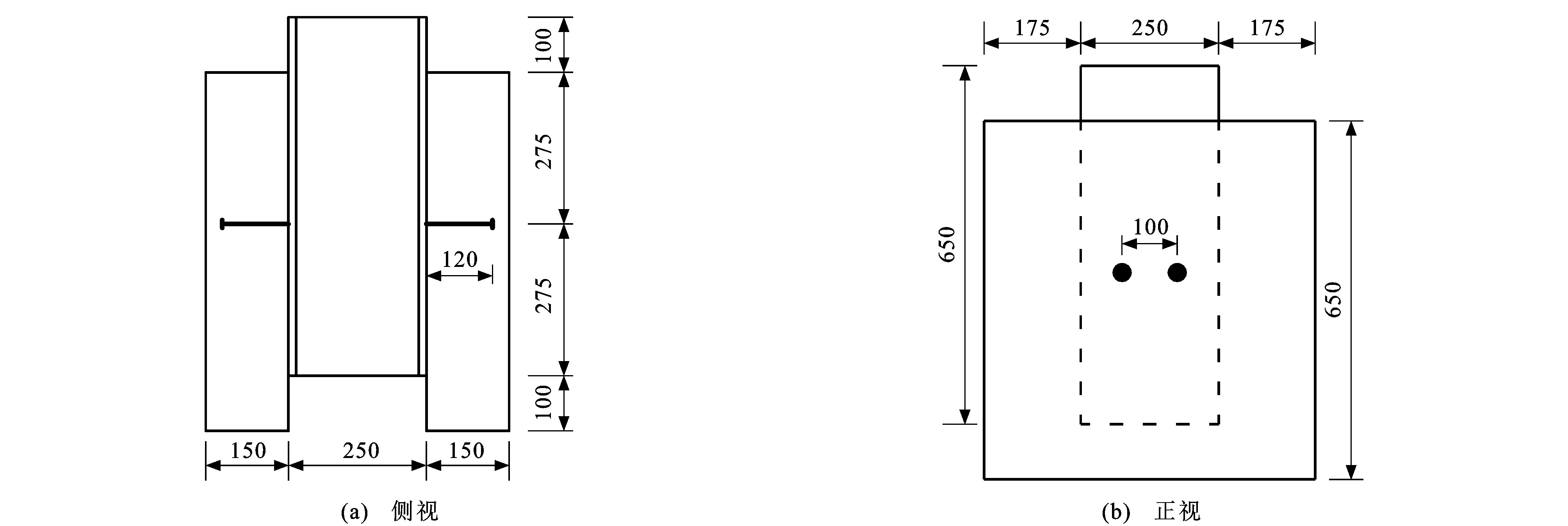Long-term push out test and finite element analysis of steel-concrete composite specimens
-
摘要: 采用推出试验和有限元方法研究了采用不同剪力连接件的钢-混凝土组合试件的界面长期滑移和应变发展过程; 参考Eurocode 4中推出试验标准试件, 设计了2组试件用于长期推出试验; 分别采用栓钉和PBL作为剪力连接件, 采用螺杆施加长期荷载, 测试了长期加载过程中的界面滑移、混凝土应变和钢梁应变; 同步加载测试了150 mm×150 mm×300 mm的混凝土试块的长期变形, 并以此变形计算混凝土徐变系数; 对比了徐变模型对计算结果的影响, 并讨论了不同混凝土徐变模拟方法。研究结果表明: 界面滑移和混凝土应变在加载初期增长较快, 加载120 d后达到稳定状态; 栓钉试件和PBL试件的最大界面滑移分别为0.162和0.068 mm, 最大值均位于界面底部; 栓钉试件和PBL试件的混凝土最大应变分别为7.30×10-5和1.34×10-4, 最大值均位于混凝土板底部; 钢梁应变在整个试验过程中基本保持稳定, 未出现明显的应力重分布, 栓钉试件和PBL试件的钢梁最大应变分别为3.7×10-5和6.5×10-5, 最大值均位于钢梁顶部; 混凝土徐变是影响钢-混凝土组合试件长期性能的主要因素, 不同混凝土徐变模型计算所得混凝土徐变系数与测试值的偏差为60%~140%, 说明混凝土徐变模型对有限元结果影响显著; 采用指数函数拟合混凝土徐变系数测试结果的拟合误差为2.4%, CEB-FIP90模型计算所得混凝土徐变系数在加载后期与测试值的误差为3.71%, 建议无法实测时可采用CEB-FIP90模型计算混凝土徐变系数。Abstract: The long-term interface slip and strain development process for steel-concrete composite specimens with different shear connectors were investigated through the push out test and finite element method. Referring to the standard specimen of push out test in the Eurocode 4, two sets of specimens were designed for the long-term push out tests. The studs and PBLs were used as the shear connectors, respectively, the long-term load was applied by screw rods, and the interface slip, concrete strain and steel girder strain were measured during the long-term loading process. The long-term deformations of concrete specimens with the dimensions of 150 mm×150 mm×300 mm were loaded and tested synchronously to calculate the concrete creep coefficient. The effect of creep model on the calculation result was compared, and different concrete creep simulation methods were discussed. Research result shows that the interface slip and concrete strain increase rapidly at the initial stage of loading and keep stable in 120 d after loading. The maximum interface slips of stud specimens and PBL specimens are 0.162 and 0.068 mm, respectively, and located at the bottom of interface. The maximum concrete strains of stud specimens and PBL specimens are 7.30×10-5 and 1.34×10-4, respectively, and located at the bottom of concrete slab. The steel girder strain remains basically stable during the whole test process. There is no obvious stress redistribution. The maximum steel girder strains of stud specimens and PBL specimens are 3.7×10-5 and 6.5×10-5, respectively, and located at the top of steel girder. The concrete creep is the main factor affecting the long-term performance of steel-concrete composite specimen. The errors between the concrete creep coefficients calculated by different concrete creep models and the test values are 60%-140%, indicating that the concrete creep model has a significant impact on the finite element results. When using the exponential function to fit the test result of concrete creep coefficient, the fitting error is 2.4%. The error between the concrete creep coefficient calculated by the CEB-FIP90 model and test value is 3.71% at the later loading stage. The CEB-FIP90 model is recommended to calculate the concrete creep coefficient when the actual test cannot be carried out.
-
Key words:
- bridge engineering /
- shear connector /
- push out test /
- finite element analysis /
- long-term performance /
- stud /
- PBL
-
表 1 钢材力学性能
Table 1. Mechanical properties of steels
试件 屈服强度/MPa 极限强度/MPa 弹性模量/GPa 泊松比 型钢翼缘 370.4 513.3 202.3 0.28 型钢腹板 331.3 468.4 204.2 0.28 开孔钢板 364.2 507.3 203.1 0.27 栓钉 263.1 499.8 203.2 0.27 钢筋 433.5 565.7 193.2 0.27 表 2 拟合系数取值
Table 2. Values of fitting coefficients
拟合系数 i=1 i=2 i=3 αi 0.60 0.30 0.10 βi -0.01 -0.05 -0.02 表 3 界面滑移曲线皮尔逊相关系数
Table 3. Pearson correlation coefficients of interface slip curves
部位 计算模型 TDFM模型 EMM模型 CEB-FIP90模型 顶部 0.987 0.971 0.978 底部 0.969 0.957 0.934 均值 0.978 0.964 0.956 -
[1] 徐腾飞, 向天宇, 赵人达. 钢筋混凝土偏心受压柱长期变形随机分析[J]. 西南交通大学学报, 2014, 49 (4): 626-630. https://www.cnki.com.cn/Article/CJFDTOTAL-XNJT201404010.htmXU Teng-fei, XIANG Tian-yu, ZHAO Ren-da. Long-term random deflection of eccentrically loaded RC column[J]. Journal of Southwest Jiaotong University, 2014, 49 (4): 626-630. (in Chinese). https://www.cnki.com.cn/Article/CJFDTOTAL-XNJT201404010.htm [2] RANZI G, LEONI G, ZANDONINI R. State of the art on the time-dependent behaviour of composite steel-concrete structures[J]. Journal of Constructional Steel Research, 2013, 80: 252-263. doi: 10.1016/j.jcsr.2012.08.005 [3] XUE Wei-chen, DING Min, HE Chi, et al. Long-term behavior of prestressed composite beams at service loads for one year[J]. Journal of Structural Engineering, 2008, 134 (6): 930-937. doi: 10.1061/(ASCE)0733-9445(2008)134:6(930) [4] FAN Jian-sheng, NIE Jian-guo, LI Quan-wang, et al. Long-term behavior of composite beams under positive and negative bending. Ⅰ: experimental study[J]. Journal of Structural Engineering, 2010, 136 (7): 849-857. doi: 10.1061/(ASCE)ST.1943-541X.0000175 [5] 吕朝锋, 杨庆卫, 陈伟球. 收缩徐变对钢-混凝土组合梁弯曲变形的影响分析[J]. 建筑结构学报, 2010, 31 (7): 32-39. https://www.cnki.com.cn/Article/CJFDTOTAL-JZJB201007007.htmLYU Chao-feng, YANG Qing-wei, CHEN Wei-qiu. Effects of shrinkage and creep strains on bending behavior of steel-concrete composite beams[J]. Journal of Building Structures, 2010, 31 (7): 32-39. (in Chinese). https://www.cnki.com.cn/Article/CJFDTOTAL-JZJB201007007.htm [6] TEHAMI M, RAMDANE K. Creep behaviour modelling of a composite steel-concrete section[J]. Journal of Constructional Steel Research, 2009, 65 (5): 1029-1033. doi: 10.1016/j.jcsr.2009.01.001 [7] 占玉林, 向天宇, 赵人达. 几何非线性结构的徐变效应分析[J]. 工程力学, 2006, 23 (7): 45-48. doi: 10.3969/j.issn.1000-4750.2006.07.009ZHAN Yu-lin, XIANG Tian-yu, ZHAO Ren-da. Creep effect analysis of geometric nonlinear structures[J]. Engineering Mechanics, 2006, 23 (7): 45-48. (in Chinese). doi: 10.3969/j.issn.1000-4750.2006.07.009 [8] BRADFORD M A, GILBERT R I. Time-dependent behaviour of simply-supported steel-concrete composite beams[J]. Magazine of Concrete Research, 1991, 43 (157): 265-274. doi: 10.1680/macr.1991.43.157.265 [9] BRADFORD M A, GILBERT R I. Composite beams with partial interaction under sustained loads[J]. Journal of Structural Engineering, 1992, 118 (7): 1871-1883. doi: 10.1061/(ASCE)0733-9445(1992)118:7(1871) [10] GILBERT R I, BRADFORD M A. Time-dependent behavior of continuous composite beams at service loads[J]. Journal of Structural Engineering, 1995, 121 (2): 319-327. doi: 10.1061/(ASCE)0733-9445(1995)121:2(319) [11] AL-DEEN S, RANZI G, VRCELJ Z. Full-scale long-term and ultimate experiments of simply-supported composite beams with steel deck[J]. Journal of Constructional Steel Research, 2011, 67 (10): 1658-1676. doi: 10.1016/j.jcsr.2011.04.010 [12] AL-DEEN S, RANZI G, VRCELJ Z. Full-scale long-term experiments of simply supported composite beams with solid slabs[J]. Journal of Constructional Steel Research, 2011, 67 (3): 308-321. doi: 10.1016/j.jcsr.2010.11.001 [13] AL-DEEN S, RANZI G, VRCELJ Z. Long-term experiments of composite steel-concrete beams[J]. Procedia Engineering, 2011, 14: 2807-2814. doi: 10.1016/j.proeng.2011.07.353 [14] 樊健生, 聂建国, 王浩. 考虑收缩、徐变及开裂影响的组合梁长期受力性能研究(Ⅰ)——试验及计算[J]. 土木工程学报, 2009, 42 (3): 8-15. https://www.cnki.com.cn/Article/CJFDTOTAL-TMGC200903006.htmFAN Jian-sheng, NIE Jian-guo, WANG Hao. Long-term behavior of composite beams with shrinkage, creep and cracking (Ⅰ): experiment and calculation[J]. China Civil Engineering Journal, 2009, 42 (3): 8-15. (in Chinese). https://www.cnki.com.cn/Article/CJFDTOTAL-TMGC200903006.htm [15] 薛伟辰, 李杰, 何池. 预应力组合梁长期性能试验研究与时随分析[J]. 中国公路学报, 2003, 16 (4): 40-43. https://www.cnki.com.cn/Article/CJFDTOTAL-ZGGL200304009.htmXUE Wei-chen, LI Jie, HE Chi. Experimental study and time-dependent analysis of prestressed steel-concrete composite beam[J]. China Journal of Highway and Transport, 2003, 16 (4): 40-43. (in Chinese). https://www.cnki.com.cn/Article/CJFDTOTAL-ZGGL200304009.htm [16] 薛伟辰, 孙天荣, 刘婷. 2年持续荷载下城市轻轨预应力钢-混凝土组合梁试验研究[J]. 土木工程学报, 2013, 46 (3): 110-118. https://www.cnki.com.cn/Article/CJFDTOTAL-TMGC201303015.htmXUE Wei-chen, SUN Tian-rong, LIU Ting. Experimental study on prestressed steel-concrete composite beams for urban light rails under sustained loads of two years[J]. China Civil Engineering Journal, 2013, 46 (3): 110-118. (in Chinese). https://www.cnki.com.cn/Article/CJFDTOTAL-TMGC201303015.htm [17] 樊健生, 聂鑫, 李全旺. 考虑收缩、徐变及开裂影响的组合梁长期受力性能研究(Ⅱ) —理论分析[J]. 土木工程学报, 2009, 42 (3): 16-22. https://www.cnki.com.cn/Article/CJFDTOTAL-TMGC200903007.htmFAN Jian-sheng, NIE Xin, LI Quan-wang. Long-term behavior of composite beams with shrinkage, creep and cracking (Ⅱ): theoretical analysis[J]. China Civil Engineering Journal, 2009, 42 (3): 16-22. (in Chinese). https://www.cnki.com.cn/Article/CJFDTOTAL-TMGC200903007.htm [18] 孙海林, 叶列平, 陆新征. 钢-混凝土组合梁收缩和徐变的影响分析和计算[J]. 建筑结构, 2006, 36 (增1): 899-902. https://www.cnki.com.cn/Article/CJFDTOTAL-JCJG2006S1224.htmSUN Hai-lin, YE Lie-ping, LU Xin-zheng. Long term deformation analysis of shrinkage and creep of steel-concrete composite beams[J]. Building Structure, 2006, 36 (S1): 899-902. (in Chinese). https://www.cnki.com.cn/Article/CJFDTOTAL-JCJG2006S1224.htm [19] JURKIEWIEZ B, BUZON S, SIEFFERT J G. Incremental viscoelastic analysis of composite beams with partial interaction[J]. Computers and Structures, 2005, 83 (21/22): 1780-1791. [20] RANZI G, BRADFORD M A. Analytical solutions for the time-dependent behaviour of composite beams with partial interaction[J]. International Journal of Solids and Structures, 2006, 43 (13): 3770-3793. [21] 王文炜, 何初生, 冯竹林, 等. 钢-混凝土组合梁混凝土收缩徐变的增量微分方法[J]. 东南大学学报(自然科学版), 2010, 40 (6): 1252-1256. https://www.cnki.com.cn/Article/CJFDTOTAL-DNDX201006025.htmWANG Wen-wei, HE Chu-sheng, FENG Zhu-lin, et al. Incremental differential modeling of creep and shrinkage of steel-concrete composite beams[J]. Journal of Southeast University (Natural Science Edition), 2010, 40 (6): 1252-1256. (in Chinese). https://www.cnki.com.cn/Article/CJFDTOTAL-DNDX201006025.htm [22] NGUYEN Q H, HJIAJ M, ARIBERT J M. A space-exact beam element for time-dependent analysis of composite members with discrete shear connection[J]. Journal of Constructional Steel Research, 2010, 66 (11): 1330-1338. [23] GARA F, RANZI G, LEONI G. Time analysis of composite beams with partial interaction using available modelling techniques: a comparative study[J]. Journal of Constructional Steel Research, 2006, 62 (9): 917-930. [24] 赵刚云, 向天宇, 徐腾飞, 等. 钢-混凝土组合梁收缩徐变效应的随机分析[J]. 计算力学学报, 2014, 31 (1): 67-71. https://www.cnki.com.cn/Article/CJFDTOTAL-JSJG201401012.htmZHAO Gang-yun, XIANG Tian-yu, XU Teng-fei, et al. Stochastic analysis of shrinkage and creep effect of steel-concrete composite beam[J]. Chinese Journal of Computational Mechanics, 2014, 31 (1): 67-71. (in Chinese). https://www.cnki.com.cn/Article/CJFDTOTAL-JSJG201401012.htm [25] FRAGIACOMO M, AMADIO C, MACORINI L. Finite-element model for collapse and long-term analysis of steel-concrete composite beams[J]. Journal of Structural Engineering, 2004, 130 (3): 489-497. [26] 张婧, 寇立亚, 胡夏闽, 等. PBL连接件在长期荷载作用下的试验研究[J]. 工业建筑, 2018, 48 (4): 144-152. https://www.cnki.com.cn/Article/CJFDTOTAL-GYJZ201804028.htmZHANG Jing, KOU Li-ya, HU Xia-min, et al. Experimental research on perfobond shear connectors under long-term loading[J]. Industrial Construction, 2018, 48 (4): 144-152. (in Chinese). https://www.cnki.com.cn/Article/CJFDTOTAL-GYJZ201804028.htm [27] BAZANT Z P. Prediction of concrete creep effects using age-adjusted effective modulus method[J]. Journal of the American Concrete Institute, 1972, 69: 212-217. [28] MIRZA O, UY B. Finite element model for the long-term behaviour of composite steel-concrete push tests[J]. Steel and Composite Structures, 2010, 10 (1): 45-67. [29] 杨奇涛. 钢-混凝土组合连续梁桥收缩徐变效应分析[D]. 成都: 西南交通大学, 2014.YANG Qi-tao. Analysis of shrinkage and creep effect on steel-concrete composite continuous beam bridges[D]. Chengdu: Southwest Jiaotong University, 2014. (in Chinese). [30] 张望喜, 谭泽腾, 薛凯. 基于ABAQUS的钢筋混凝土收缩徐变分析[J]. 西安建筑科技大学学报(自然科学版), 2015, 47 (3): 347-353. https://www.cnki.com.cn/Article/CJFDTOTAL-XAJZ201503007.htmZHANG Wang-xi, TAN Ze-teng, XUE Kai. Analysis of shrinkage and creep of reinforced concrete based on ABAQUS[J]. Journal of Xi'an University of Architecture and Technology (Natural Science Edition), 2015, 47 (3): 347-353. (in Chinese). https://www.cnki.com.cn/Article/CJFDTOTAL-XAJZ201503007.htm -





 下载:
下载:






















